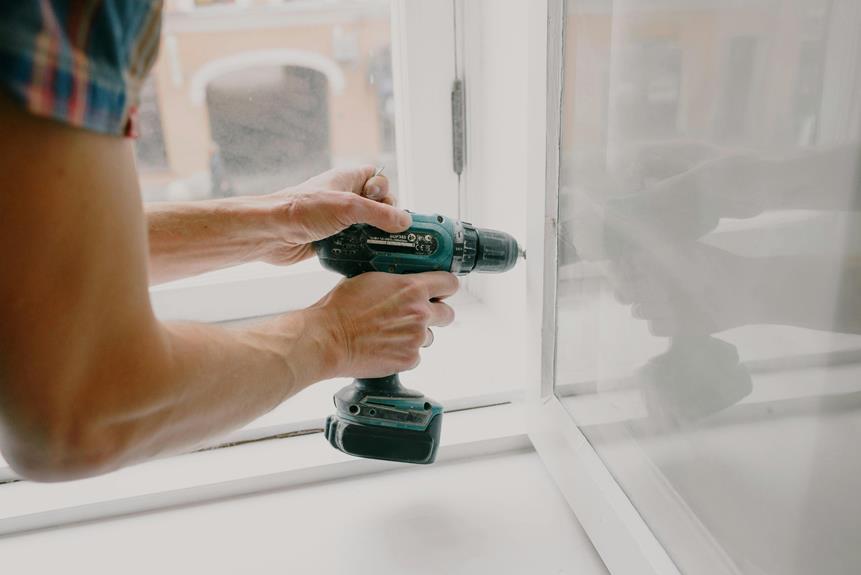Having trouble managing your finances as a stay-at-home mom? No worries! We’ve put together fifteen easy budgeting tips to help you take control of your household expenses effortlessly. These tips will empower you to make wise financial decisions and secure a stable future for your family.
By implementing these budgeting tips, you can take control of your finances and create a stable future for your family. Remember, small changes can make a big difference. Start today and enjoy the peace of mind that comes with financial security.

Set Financial Goals
To effectively manage your finances as a stay-at-home mom, it’s important to set clear and achievable financial goals. Setting SMART goals will help you gain control over your household finances and ensure a secure future for your family.
Start by identifying your priorities. Reflect on what matters most to you and your family, whether it’s saving for your children’s education, paying off debt, or building an emergency fund.
Once you know your priorities, break them down into smaller, actionable steps to make them more manageable and increase your chances of success.
Budgeting strategies are crucial for achieving your financial goals. Begin by tracking your income and expenses to understand your financial situation. Create a budget that aligns with your goals and includes all sources of income and expenses. Don’t forget to allocate funds for savings and debt repayment.
Regularly review and adjust your budget as needed to stay on track.
Track Your Expenses
Once you’ve set your financial goals, it’s important to start tracking your expenses to get a clear idea of your spending habits. Tracking your expenses may seem like a chore, but it’s a crucial step in effectively managing your finances. By keeping a record of your expenses, you can identify areas where you may be overspending and find ways to save money.
Here are some ways to track your expenses and the benefits of doing so:
- Ways to track expenses:
- Use a budgeting app or software: These tools allow you to input your expenses and categorize them, making it easier to track your spending.
- Keep a spending journal: Write down your expenses daily or weekly in a notebook or spreadsheet to have a tangible record of your spending.
- Benefits of tracking expenses:
- Gain control over your finances: Tracking your expenses gives you a clear picture of where your money is going, allowing you to make informed decisions about your spending.
- Identify areas for improvement: By tracking your expenses, you can spot patterns of overspending and find ways to cut back and save money.
- Achieve your financial goals: When you know exactly how much you’re spending and where you can align your expenses with your financial goals and work towards achieving them.
Tracking your expenses is an essential part of managing your finances and achieving financial stability. It provides you with a sense of control, helps you make better financial decisions, and ultimately leads to a more secure financial future. Start tracking your expenses today and see the positive impact it can have on your financial well-being.
Create a Budget
Start by figuring out how much money you make each month and what your fixed expenses are. This will help you create a budget that aligns with your financial goals. Setting clear goals is important because it keeps you motivated and focused on your financial journey, whether you’re saving for your child’s education or paying off debt.
To create a budget, you need to keep track of your expenses. This will help you see where your money is going and find areas where you can cut back. You can use a simple table like the one below to track your expenses:
| Expense Category | Monthly Amount |
|---|---|
| Housing | $X |
| Utilities | $X |
| Groceries | $X |
| Transportation | $X |
In the first column, list different expense categories like housing, utilities, groceries, and transportation. In the second column, write down how much money you spend on each category every month. This will give you a clear picture of your fixed expenses.
Once you have a clear idea of your income and fixed expenses, you can start allocating money to other categories like savings, entertainment, and miscellaneous expenses. Remember, budgeting is about finding a balance between saving for the future and enjoying the present.
Prioritize Essential Expenses
Once you have created a budget that aligns with your financial goals and tracked your expenses, the next step is to prioritize your essential expenses. This means identifying and categorizing your expenses into two main categories: essential and non-essential expenses.
Prioritizing essential expenses ensures that you cover your basic needs and financial obligations before allocating money toward non-essential items or wants.
To help you prioritize your essential expenses, here are two sub-lists to consider:
- Essential Expenses:
- Housing: Make sure to allocate funds for rent or mortgage payments, property taxes, and utility bills.
- Food and groceries: Set aside a reasonable amount for nutritious meals and essential household items.
- Transportation: Budget for fuel, public transportation costs, and car maintenance.
- Health insurance and medical expenses: It’s important to have adequate coverage and budget for copayments or deductibles.
- Debt payments: Prioritize paying off high-interest debts such as credit card balances or loans.
- Budgeting for Emergencies:
- Emergency fund: Set aside a portion of your income for unexpected expenses or emergencies.
- Insurance: Consider obtaining coverage for health, home, car, or life to protect yourself and your family from unforeseen events.
Cut Back on Non-Essential Spending
To save money and stick to your budget, it’s important to cut back on non-essential spending. By making a few adjustments to your spending habits, you can free up more money for your family’s needs.
One area where you can start cutting back is on entertainment expenses. Instead of going out to expensive restaurants or movie theaters, try hosting movie nights at home or having a picnic in the park. This way, you can still enjoy quality time with your loved ones without spending too much.
Another way to save money is by finding affordable options for online shopping. Many websites offer great deals and discounts on a wide range of products. Take advantage of these sales and compare prices before making a purchase.
Consider shopping at thrift stores or consignment shops for clothing and household items. You can find high-quality items at a fraction of the price.
Cutting back on non-essential spending has several benefits. Similarly, by skipping movie theaters, you can lower your entertainment expenses. When it comes to online shopping, finding affordable options can help you save money. And shopping at thrift stores can help you find quality clothing and household items at a lower cost.
Meal Plan and Grocery Shop Strategically
To save money and reduce food waste, it’s important to plan your meals and shop strategically. By following these tips, you can make the most of your budget while ensuring your family enjoys delicious and nutritious meals.
Create a weekly meal plan. Take some time each week to plan your meals, using ingredients you already have at home. This will help you avoid spontaneous and expensive grocery trips. Next, make a detailed shopping list before heading to the grocery store. Stick to the list to avoid unnecessary purchases.
When shopping, keep a budget in mind and stick to it. This will help you avoid overspending and keep your expenses in check. Look for sales, promotions, and coupons to save money on essential items. Take advantage of these opportunities to get the best deals.
Consider buying non-perishable items in bulk to save money in the long run. Just make sure they’re items you use regularly to avoid wastage. Opt for in-season produce, as it tends to be cheaper and fresher.
Use Cash Envelopes for Spending Categories
Consider using cash envelopes to allocate and track your spending in different categories. The cash envelope system is a simple and effective way to manage your finances as a stay-at-home mom.
One benefit of using cash envelopes is that it helps you see your spending. When you have a set amount of cash in each envelope, you can physically see how much money you have left for that category. This visual reminder can prevent impulsive purchases or going over budget.
Using the cash envelope system promotes accountability and mindfulness. When you use cash, you become more aware of your spending habits and can make conscious decisions about where your money goes. This can lead to better financial discipline and help you prioritize your expenses.
Furthermore, using cash envelopes helps you avoid relying too heavily on credit cards or accumulating debt. By using cash for your everyday expenses, you can stay within your means and resist the temptation to overspend. It’s a practical way to manage your finances and maintain financial stability.
Reduce Energy and Utility Costs
Save money on your monthly expenses by implementing energy-saving measures and reducing utility costs. As a stay-at-home mom, you can take simple steps to reduce water usage and lower heating costs, contributing to a more sustainable and budget-friendly lifestyle. Here are some tips to help you get started:
- Reduce water usage:
- Fix any leaks in faucets or toilets promptly.
- Install low-flow showerheads and faucets to use less water.
- Only run the dishwasher and washing machine with full loads.
- Water your plants and garden during cooler hours to minimize evaporation.
- Lower heating costs:
- Set your thermostat to a lower temperature during colder months and wear warm clothing indoors.
- Use draft stoppers to keep cold air from entering your home.
- Insulate your windows with weatherstripping or plastic film to retain heat.
- Open curtains and blinds during the day to let sunlight naturally warm your home.
Find Creative Ways to Save on Childcare
Maximize your savings as a stay-at-home mom by finding innovative ways to reduce childcare expenses. Budgeting for stay-at-home moms can be challenging, but with the right strategies, you can save on childcare costs. Here are some cost-saving strategies to consider:
- Share childcare responsibilities: Connect with other stay-at-home moms in your community and explore the possibility of sharing childcare duties. Take turns watching each other’s children, giving you some free time while saving on daycare costs.
- Look for part-time childcare options: Instead of enrolling your child in full-time daycare, consider part-time options. This can significantly reduce your childcare expenses while still ensuring quality care for your child.
- Utilize community resources: Many communities offer free or low-cost childcare programs or playgroups. Research local organizations, libraries, and community centers that provide such services.
- Seek family help: If you have family members nearby, reach out to them for assistance with childcare. Grandparents or other relatives may be willing to help out, allowing you to save on daycare costs.
- Explore work-from-home opportunities: If possible, look into work-from-home options that allow you to be present for your child while still earning an income. This can help offset the costs of childcare.
Explore Money-Saving Apps and Websites
Discover how money-saving apps and websites can help you stretch your budget as a stay-at-home mom. In today’s digital age, there are numerous tools available that can assist you in finding great deals and saving money.
Here are some ways you can explore cashback opportunities and comparison shop online:
- Cashback Opportunities:
- Use cashback apps on your smartphone: Take advantage of apps like Rakuten, Ibotta, or Honey that offer cashback rewards on your purchases. Simply scan your receipts or shop through their partner stores to earn cashback.
- Sign up for cashback websites: Websites like Swagbucks or TopCashback allow you to earn cashback by shopping through their links. You can also earn additional rewards by completing surveys or watching videos.
- Comparison Shop Online:
- Utilize price comparison websites: Websites like PriceGrabber or CamelCamelCamel can help you compare prices across different retailers. This way, you can ensure that you’re getting the best possible deal on the items you need.
- Install browser extensions: Browser extensions like Honey or Wikibuy automatically search for coupon codes and discounts while you shop online. These tools can save you time and money by finding the best deals for you.
DIY Household Products and Repairs
Let’s shift our focus to DIY household products and repairs, so you can save money and take care of your home on your own. As a stay-at-home mom, finding ways to save money while still maintaining your home is essential.
Creating your DIY beauty products is a great way to do this. Not only will it save you money, but it also ensures that you’re using natural and organic ingredients that are safe for you and your family.
You can make simple face masks using ingredients from your kitchen, as well as homemade body scrubs and hair treatments. The possibilities for creating your beauty products are endless.
Another area where you can save money is home organization. Instead of buying expensive storage solutions, consider repurposing items you already have or creating your own. For example, you can use mason jars to store small items like buttons or craft supplies. Shoeboxes can be repurposed and decorated to use as storage bins.
Don’t be afraid to tackle small repairs on your own. With the help of online tutorials and guides, you can learn how to fix leaky faucets, repair small holes in walls, or even paint a room. These DIY repairs can save you money on hiring professionals and give you a sense of accomplishment as you take care of your home.
Shop Secondhand and Thrift Stores
Consider shopping at secondhand and thrift stores to find affordable and unique items for your home. Not only will you save money, but you’ll also contribute to the sustainability movement by giving these items a second life.
Here are some reasons why shopping at thrift stores is a great idea:
- Great deals: Thrift stores often offer amazing deals on various items, from furniture to home decor. You can find gently used items at a fraction of their original price, allowing you to stretch your budget further.
- Fashion finds: Thrift stores are a treasure trove of fashionable clothing at affordable prices. You can find unique pieces that stand out from the crowd, allowing you to express your style without breaking the bank.
- Supporting local communities: Shopping at thrift stores supports local charities and nonprofit organizations. By purchasing from these stores, you contribute to their mission of helping those in need and creating a sense of belonging and community.
- Reducing waste: By shopping secondhand, you actively participate in reducing waste and promoting sustainability. When you buy used items, you prevent them from ending up in landfills, which helps protect the environment for future generations.
Shopping at secondhand and thrift stores not only benefits your wallet but also allows you to find one-of-a-kind items while supporting your local community and the planet. So next time you need something for your home, consider giving thrift stores a chance.
Optimize Your Health and Wellness Budget
To get the most out of your health and wellness budget, focus on spending on essential items and services that will have the biggest impact on your overall well-being. One way to optimize your fitness budget is by finding affordable wellness activities.
Look for local community centers or parks that offer free or low-cost exercise classes. Many gyms also offer discounted rates for specific time slots or off-peak hours. Take advantage of these options to stay active without spending too much.
Another option is to invest in basic exercise equipment that you can use at home, such as resistance bands or a jump rope. These items are affordable and versatile, allowing you to create a variety of workouts without the need for an expensive gym membership.
When it comes to wellness activities, explore low-cost options like meditation apps or online yoga classes. Many platforms offer free trial periods or discounted rates for new members. You can also check out your local library for books or DVDs on wellness topics, such as healthy cooking or stress management.
Find Ways to Earn Extra Income
To improve your financial situation, consider finding ways to earn extra money. As a stay-at-home mom, you can capitalize on your hobbies and explore remote job opportunities to contribute to your family’s finances. Here are some ideas to help you get started:
- Monetize your hobbies: Start a blog or YouTube channel that focuses on your interests or expertise. You can make money through sponsored content, affiliate marketing, or by selling your products. Another option is to use your crafting skills to create personalized items for friends, family, or an online store. Platforms like Etsy make it easy to sell your handmade goods.
- Remote job opportunities: If you have expertise in a particular field, consider freelancing. Websites like Upwork and Freelancer connect freelancers with clients who are looking for their skills. Additionally, you can explore remote customer service or virtual assistant positions. Many companies now hire remote workers to handle customer inquiries or provide administrative support.
Regularly Review and Adjust Your Budget
Regularly reviewing and adjusting your budget is essential to staying on track with your finances as a stay-at-home mom. By regularly reviewing your budget, you can identify unnecessary expenses and find ways to save money.
Start by categorizing your expenses into needs and wants. This will help you prioritize your spending and identify areas where you can cut back. Look for recurring expenses that you no longer need or can find cheaper alternatives for. For example, you might realize that you’re spending too much on subscriptions you no longer use or that you can find similar products at a lower cost.
In addition to identifying unnecessary expenses, reviewing your budget regularly allows you to make adjustments based on changes in your financial situation. As your family’s needs and income change, it’s important to update your budget accordingly.
This could mean adding new expenses, such as childcare or extracurricular activities for your children, or adjusting your savings goals.
Conclusion
Simple budgeting tips can empower stay-at-home moms to make informed financial decisions and alleviate stress related to money management.
By setting financial goals, seeking cost-effective solutions, and practicing smart spending habits, stay-at-home moms can achieve financial stability and ensure the well-being of their families.











